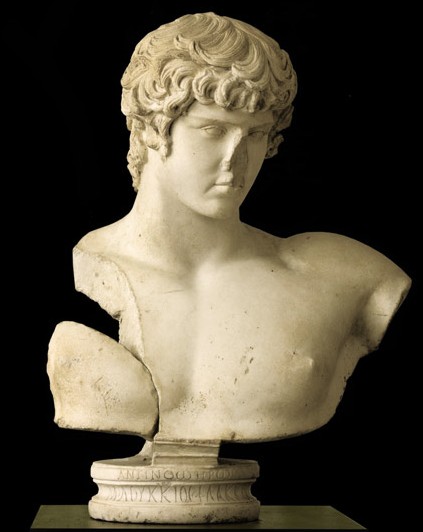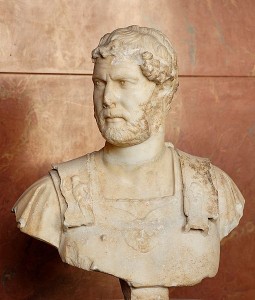 Last Wednesday night, in a swanky hall at Sotheby’s in New York, auctioneer Hugh Hildesley opened bidding for a sculptural masterpiece from the Roman world. Art collectors knew this statue as A Marble Portrait Bust of the Deified Antinous, and Hildesley and his staff expected that it would sell in the two- to three-million dollar range.
Last Wednesday night, in a swanky hall at Sotheby’s in New York, auctioneer Hugh Hildesley opened bidding for a sculptural masterpiece from the Roman world. Art collectors knew this statue as A Marble Portrait Bust of the Deified Antinous, and Hildesley and his staff expected that it would sell in the two- to three-million dollar range.
That didn’t happen though.
 Instead five determined bidders–four seated in the hushed hall and one calling in bids frantically by phone–launched a checkbook war that electrified even the rarefied crowd at Sotheby’s. In just over 11 minutes, these five clients drove the price of the statue from Hildesley’s opening bid of $900,000 to a figure that I can’t even begin to comprehend: $23,826,500. The successful bidder was an anonymous European collector.
Instead five determined bidders–four seated in the hushed hall and one calling in bids frantically by phone–launched a checkbook war that electrified even the rarefied crowd at Sotheby’s. In just over 11 minutes, these five clients drove the price of the statue from Hildesley’s opening bid of $900,000 to a figure that I can’t even begin to comprehend: $23,826,500. The successful bidder was an anonymous European collector.
Sotheby’s later made much of the fact that the proceeds will go to a charitable organization founded by the statue’s former owner, Clarence Day, a reclusive Mississippian millionaire and art collector who died roughly a year ago. That, of course, put a very positive spin on the sale, for it’s hard to criticize an auction that raises $23 million for people in need of help.
But I don’t see things quite that way, and it’s not because I’ve succumbed to the grinchy time of year. This statue is much more than an art treasure or a marketable commodity. It is a very rare archaeological artifact that shows us something important about the private life of a Roman emperor.
 Antinous was the favorite companion of Hadrian, a rather homely looking man (left) who spent much of his reign inspecting remote imperial outposts. Some classical histories say that Hadrian first met Antinous while the imperial household was journeying through northwest Turkey. Others say that Hadrian commanded his subordinates to scour the Empire for the most beautiful boy they could find. I don’t have a clue which, if either, is true, but after seeing the statue of Antinous, I’m inclined to believe theory number two.
Antinous was the favorite companion of Hadrian, a rather homely looking man (left) who spent much of his reign inspecting remote imperial outposts. Some classical histories say that Hadrian first met Antinous while the imperial household was journeying through northwest Turkey. Others say that Hadrian commanded his subordinates to scour the Empire for the most beautiful boy they could find. I don’t have a clue which, if either, is true, but after seeing the statue of Antinous, I’m inclined to believe theory number two.
The boy became Hadrian’s constant companion: he might have become emperor’s lover as well. No one knows for certain. But eventually the relationship ended badly. In A.D. 130, Antinous drowned in the Nile, and Hadrian went half mad with grief. Soon after, he declared Antinous a god.
I dearly wish this statue had never reached the auction block. It is the only known Classical portrait of Antinous–our very best representation of what he looked like and how he won the heart of an emperor. (The inscription at the base confirms the identity of the boy.) And for this reason alone, this statue deserves to be in a major museum, where all can gaze on it and reflect on the long-ago passion of a rough and ready Roman emperor.
But beyond that, the record-smashing sale price of this statue sends a very bad message to people who loot tombs and archaeological sites in the former Roman Empire. Collectors are now clearly willing to pay through the nose for high-quality Roman statuary with a story. And this is very dismal news indeed for archaeologists.
Upper Photo: A Marble Portrait of the Diefied Aninous. Courtesy Sotheby’s. Middle Photo: Sotheby’s in New York. Courtesy Jim Henderson. Lower Photo: Emperor Hadrian, a statue in the Louvre. Courtesy Jastrow.
I see your point, Heather, but…. don’t you think that because of this crazy auction, a lot more people will read about (and look at photos of) this beautiful boy than if it quietly went into a museum? Without LWON and other media accounts, I must admit that all busts sort of look the same to me.
Yes, I see what you mean, Virginia. And it’s an excellent point.Communicating with the public is something that museums and archaeologists alike need to be focusing on much more. Sometimes the stories behind these artifacts are incredible. But in the press releases and other media accounts, there were very few mentions of who Antinous was and what role he played in Hadrian’s life. Instead the press coverage concentrated almost exclusively on the price the bust brought at auction. The message was all about money, and that worries me. Looters and antiquities dealers pay close attention to sale prices.
Two points, Heather :-
(1) Because the bust had its original inscription intact identifying Antinous, it made the bust especially attractive to a major collector (museum?) of antique statuary as concrete proof of his facial features. Quite a few busts and statues are either outright reproductions (often from the 18thCent when the Hadrian/Antinous relationship was a popular & valuable collector’s theme), or occasionally of uncertainty in whether it is Antinous.
And (2):- I do not think the bust of Hadrian you display is in fact Hadrian. The features shown in the photo do not compare favorably with the many comparable busts & statues of Hadrian evident in museums or books.
Separately, your readers might be interested in the recently published novel “THE HADRIAN ENIGMA: A Forbidden History” which – though being romantic fiction – follows the historical record of the Hadrian/Antinous affair very closely. It is available online in paperback & ebook formats via Amazon or the iBookstore, etc.
George:
Yes, I agree that the inscription on the bust would have helped to hoist thesale price. But I can’t see any evidence to date that the buyer was a museum. There are very few museums in the world that have an acquisition budget that large and I personally think that many curators would shy away from purchasing such a costly artifact in an era of repatriation. I’d love to be proved wrong on this.
All I can say about the bust is that the Louvre, which owns it, continues to call it a bust of Hadrian. You can see this in its database:
http://cartelen.louvre.fr/cartelen/visite?srv=rs_display_res&critere=Hadrian&operator=AND&nbToDisplay=5&langue=en&x=27&y=10
I also think the Louvre bust compares very favorably to a portrait bust of Hadrian in Palazzio Massimo alle Terme in Rome.
Good luck with your book. I look forward to reading it.
This is the only Classical statue of Antinous? Really? I thought Hadrian covered the Empire in statues of him after his death and deification. I’m thinking specifically of one that showed him in Pharaonic regalia. At the least, you’d think there’d be some of him from the site at Antinoopolis. (Now there’s a romantic gesture: name a city after someone!)
Maybe it’s the collector in me, but I sometimes wonder what cultural preservationists who seem to demand that any and all works of art of any merit at all should go to museums, who should never get rid of any of them even if the building’s about the fall down and no one’s seen the works in a hundred years think museums should be. Just football stadium-sized fields of art? Why not let private collectors have some of it?
Yes, this is the only known, authenticated, Classical-era depiction of Antinous to my knowledge. There are a host of other suspected Antinous sculptures and busts out there, but they haven’t been authenticated by an inscription. This seems to be the only one.
I’m clearly on the other side of the private collecting/archaeology fence. I think really important antiquities–and this is clearly one of them–should be in museums where everyone can see and admire and study them. I don’t think they should be displayed in some collector’s living room or stowed in a locked vault. I think we’ll have to agree to disagree.